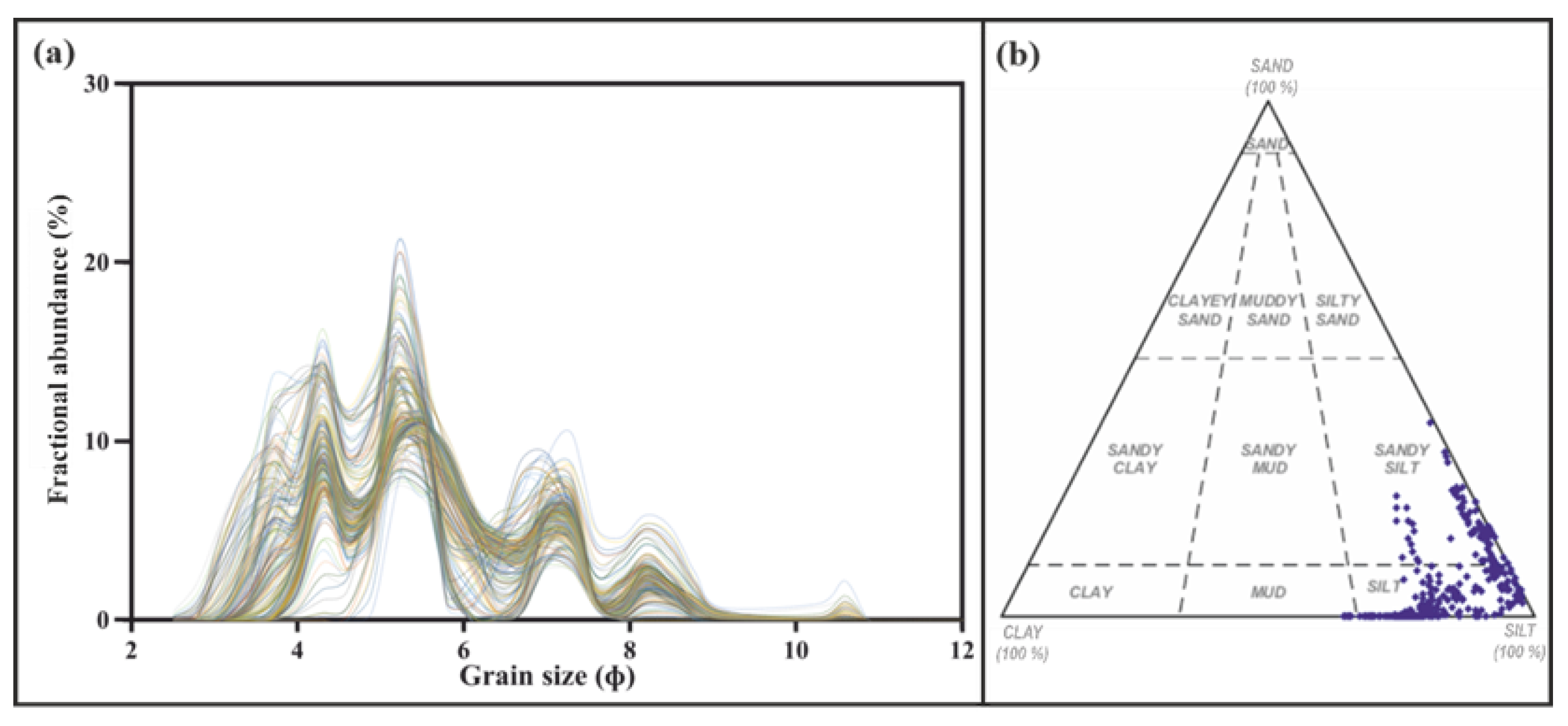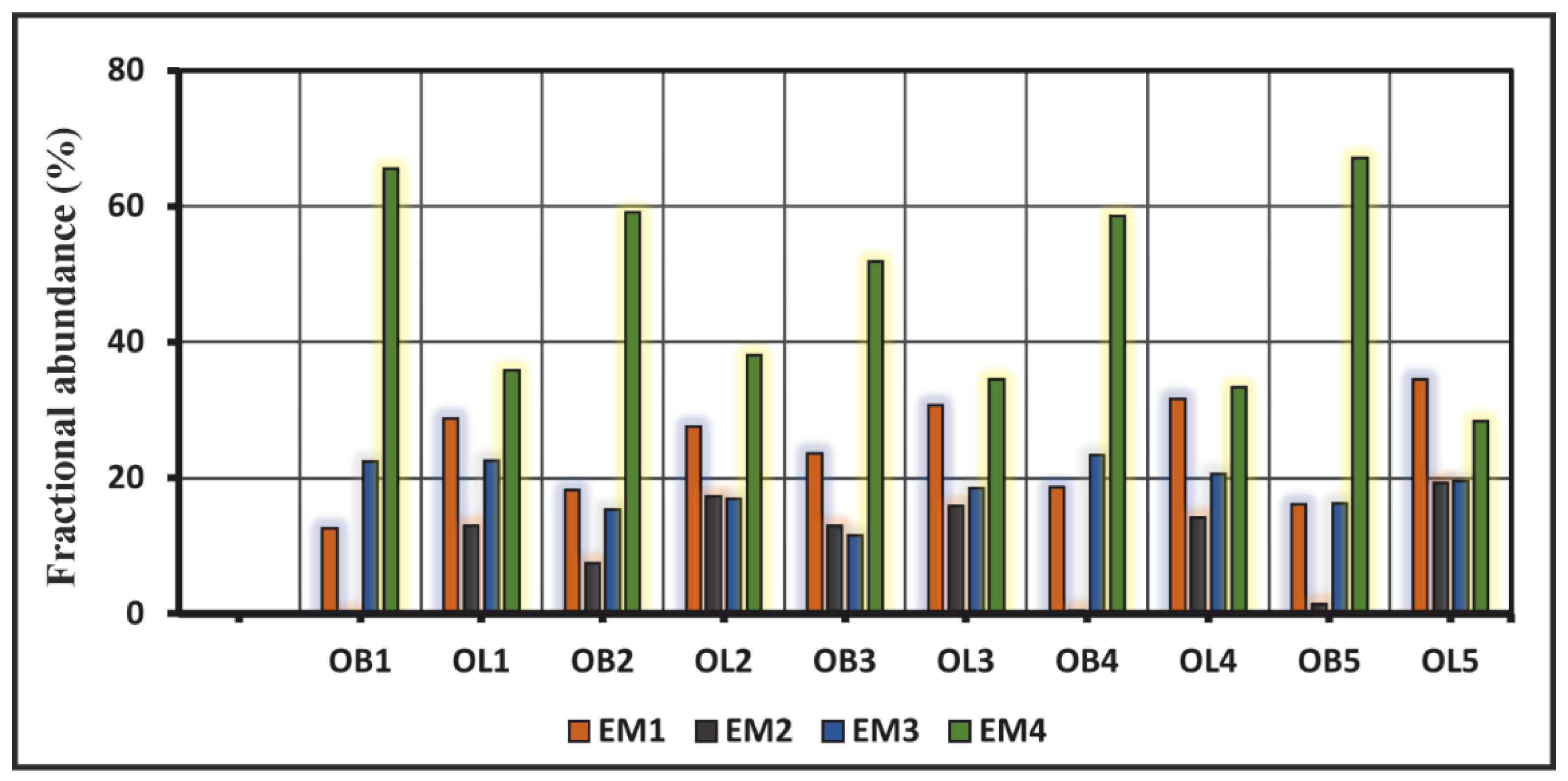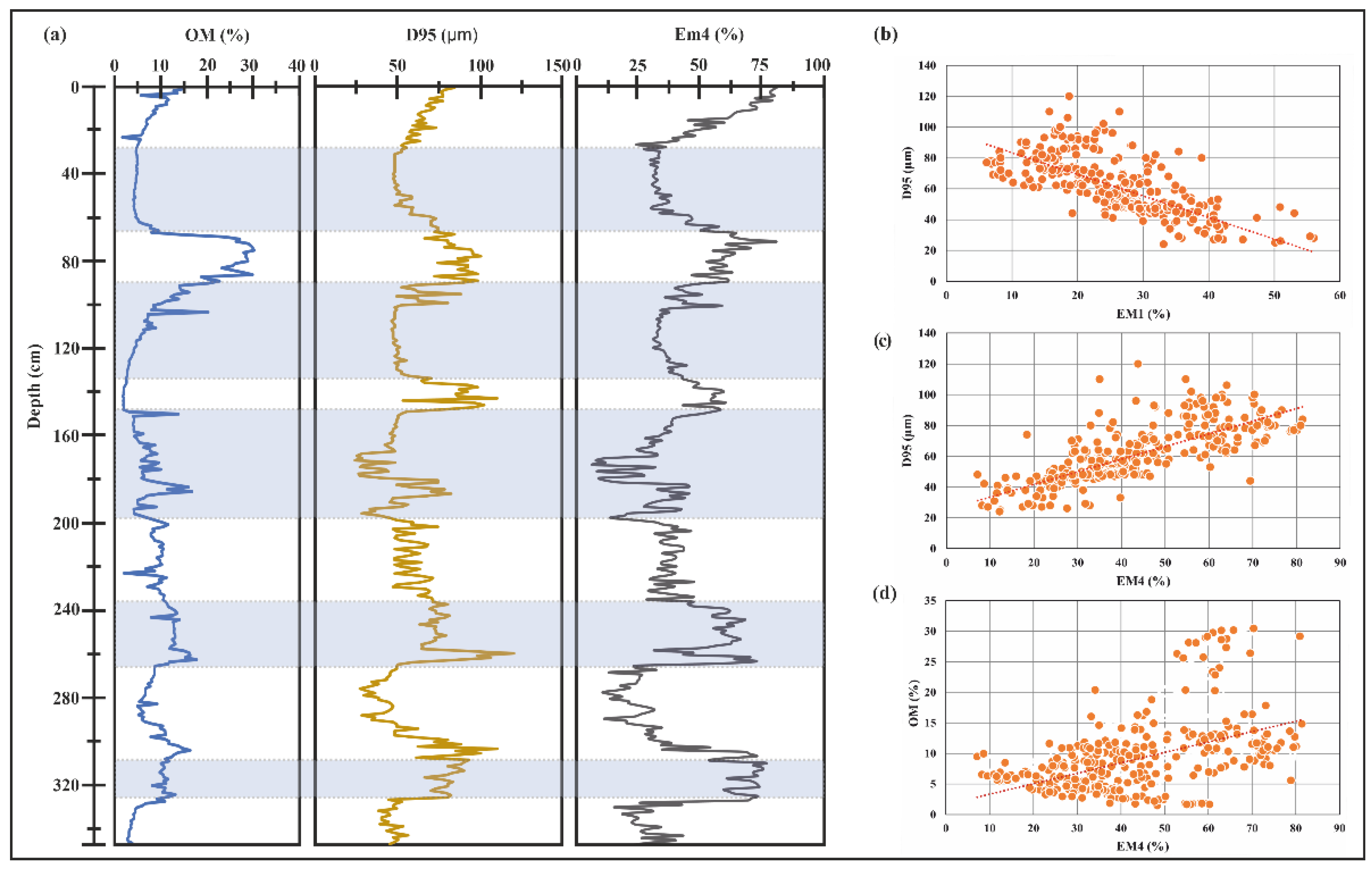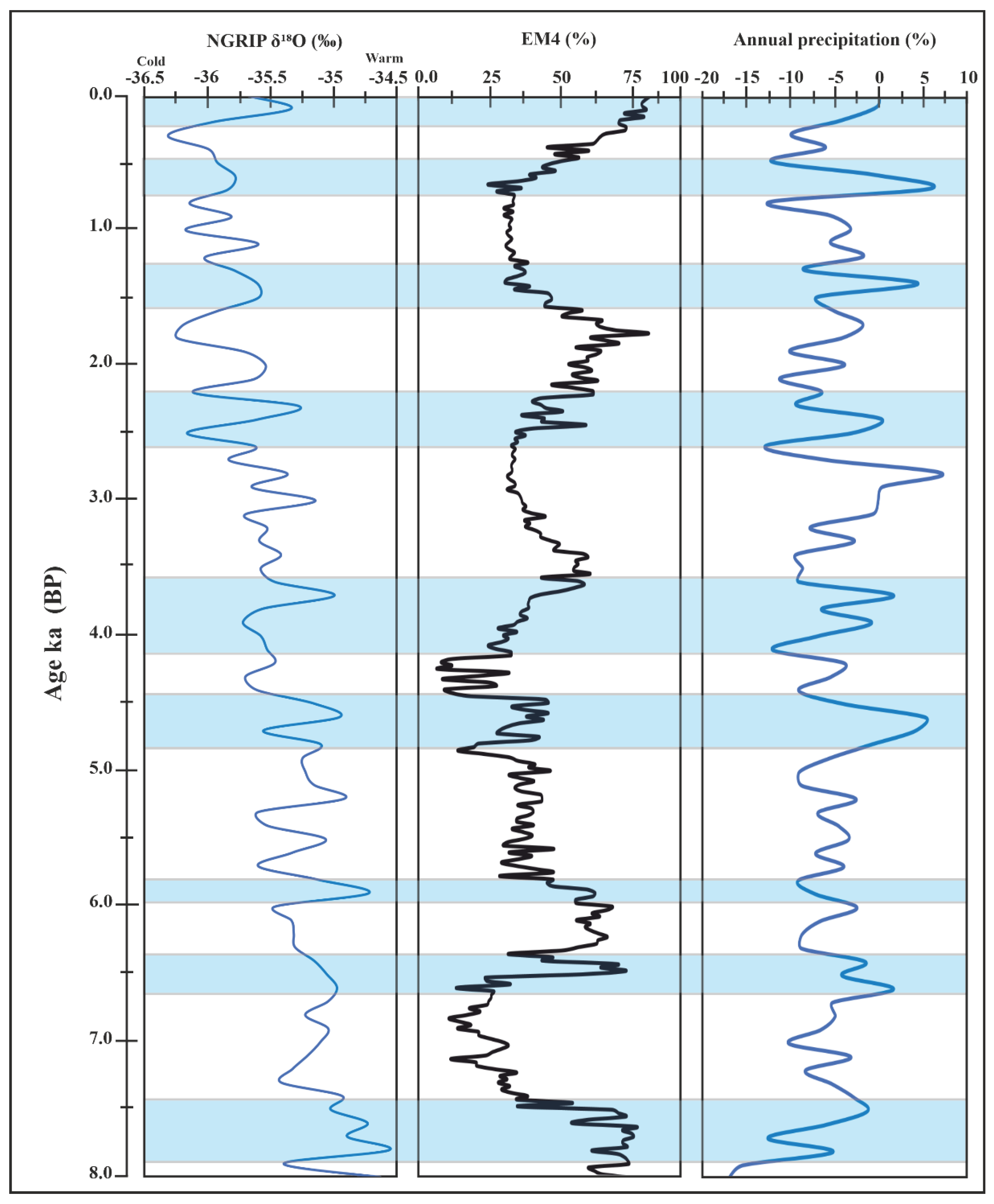Application of Parameterized Grain-Size Endmember Modeling in the Study of Quaternary Oxbow Lake Sedimentation: A Case Study of Tövises Bed Sediments in the Eastern Great Hungarian Plain
Abstract
:1. Introduction
2. Materials and Methods
2.1. Lithology and Geochronology
2.2. Grain-Size Analysis and Endmember Modeling (EMM)
2.3. Loss-On-Ignition (LOI) and Magnetic Susceptibility (MS)
3. Results
3.1. Lithology and Stratigraphic Divisions
3.2. Grain-Size Distribution (GSD) and Endmember Modeling (EMM)
3.2.1. Grain-Size Distribution (GSD)
3.2.2. Endmember Modeling (EMM)
3.3. Loss-On-Ignition (LOI) and Magnetic Susceptibility (MS) Characteristics
4. Discussion
5. Conclusions
- The age–depth model indicates that the core sequence represents sediment accumulation since 8000 BP. The grain-size composition, lithofacies, LOI, and MS reveal varying climatic conditions of wet and dry periods; the Tövises bed paleochannel evolved through an early lacustrine phase (oxbow lake) gradually infilled by lacustrine gyttjas, interbedded with wetland histosol, and periodically accumulated flood deposits.
- The parameterized endmember modeling resulted in four endmembers (EM1–4), indicating different sedimentation conditions: EM1 is clay to very fine silt component of the oxbow lake filling, representing the lacustrine phase. EM2 and EM3 represent the intermediate component representing mainly silt transported resulting from a moderate flood; EM4 is a fraction of material transported during a significant flood when the river discharge was relatively high; it represents the overbank deposition phase.
- This study demonstrates that partitioning the grain-size distribution of abandoned channel sediments into statistically robust grain-size endmembers provides various quantitative proxies that help to model the complex paleoenvironmental changes and climate history in the region during the Holocene.
Author Contributions
Funding
Data Availability Statement
Conflicts of Interest
References
- Shen, Z.; Aeschliman, M.; Conway, N. Paleodischarge reconstruction using oxbow lake sediments complicated by shifting hydrological connectivity. Quat. Int. 2021, 604, 75–81. [Google Scholar] [CrossRef]
- Toonen, W.H.J.; Kleinhans, M.G.; Cohen, K.M. Sedimentary architecture of abandoned channel fills. Earth Surf. Process. Landf. 2012, 37, 459–472. [Google Scholar] [CrossRef]
- Collinson, J.D.; Lewin, J. Alluvial cutoofs in Wales and the Borderlands. In Modern and Ancient Fluvial Systems; John Wiley & Sons, Inc.: Hoboken, NJ, USA, 1983. [Google Scholar]
- Hooke, J.M. River channel adjustment to meander cutoffs on the River Bollin and River Dane, northwest England. Geomorphology 1995, 14, 235–253. [Google Scholar] [CrossRef]
- Constantine, J.A.; Dunne, T.; Piégay, H.; Mathias Kondolf, G. Controls on the alluviation of oxbow lakes by bed-material load along the Sacramento river, California. Sedimentology 2010, 57, 389–407. [Google Scholar] [CrossRef]
- Sun, D.; Bloemendal, J.; Rea, D.K.; Vandenberghe, J.; Jiang, F.; An, Z.; Su, R. Grain-size distribution function of polymodal sediments in hydraulic and aeolian environments, and numerical partitioning of the sedimentary components. Sediment. Geol. 2002, 152, 263–277. [Google Scholar] [CrossRef]
- Shang, Y.; Beets, C.J.; Tang, H.; Prins, M.A.; Lahaye, Y.; van Elsas, R.; Sukselainen, L.; Kaakinen, A. Variations in the provenance of the late Neogene Red Clay deposits in northern China. Earth Planet. Sci. Lett. 2016, 439, 88–100. [Google Scholar] [CrossRef]
- Liang, X.; Niu, Q.; Qu, J.; Liu, B.; Liu, B.; Zhai, X.; Niu, B. Applying end-member modeling to extricate the sedimentary environment of yardang strata in the Dunhuang Yardang National Geopark, northwestern China. Catena 2018, 180, 238–251. [Google Scholar] [CrossRef]
- Kong, F.; Xu, S.; Han, M.; Chen, H.; Miao, X.; Kong, X.; Jia, G. Application of grain size endmember analysis in the study of dust accumulation processes: A case study of loess in Shandong Province, East China. Sediment. Geol. 2021, 416, 105868. [Google Scholar] [CrossRef]
- Meyer, I.; Van Daele, M.; Tanghe, N.; De Batist, M.; Verschuren, D. Reconstructing East African monsoon variability from grain-size distributions: End-member modeling and source attribution of diatom-rich sediments from Lake Chala. Quat. Sci. Rev. 2020, 247, 106574. [Google Scholar] [CrossRef]
- Li, T.; Li, T.J. Sediment transport processes in the Pearl River Estuary as revealed by grain-size end-member modeling and sediment trend analysis. Geo-Mar. Lett. 2018, 38, 167–178. [Google Scholar] [CrossRef]
- Ha, H.J.; Chang, T.S.; Ha, H.K. Using end-member analysis to determine sediment dispersal and depositional processes on the Heuksan mud belt, southwest Korean shelf. Geo-Mar. Lett. 2021, 41, 1–13. [Google Scholar] [CrossRef]
- de Mahiques, M.M.; Goya, S.C.; de Oliveira, R.A.; Kim, B.S.; de Lima Ferreira, P.A.; Figueira, R.C.; Bícego, M.C. Grain-size end-members and environmentally sensitive grain-size components: A comparative study in the mud shelf depocenters off southern Brazil. Int. J. Sediment Res. 2021, 36, 317–327. [Google Scholar] [CrossRef]
- Huang, Y.; Xiao, J.; Xiang, R.; Liu, S.; Khokiattiwong, S.; Kornkanitnan, N.; Fan, J.; Wen, R.; Zhang, S.; Liu, J. Holocene Indian Summer Monsoon variations inferred from end-member modeling of sediment grain size in the Andaman Sea. Quat. Int. 2020, 558, 28–38. [Google Scholar] [CrossRef]
- Vandenberghe, J.; Sun, Y.; Wang, X.; Abels, H.A.; Liu, X. Grain-size characterization of reworked fine-grained aeolian deposits. Earth-Sci. Rev. 2018, 177, 43–52. [Google Scholar] [CrossRef]
- Zhang, X.; Zhang, H.; Chang, F.; Xie, P.; Li, H.; Wu, H.; Ouyang, C.; Liu, F.; Peng, W.; Zhang, Y. Long-range transport of aeolian deposits during the last 32 kyr inferred from rare earth elements and grain-size analysis of sediments from Lake Lugu, Southwestern China. Palaeogeogr. Palaeoclimatol. Palaeoecol. 2021, 567, 110248. [Google Scholar] [CrossRef]
- IJmker, J.; Stauch, G.; Dietze, E.; Hartmann, K.; Diekmann, B.; Lockot, G.; Opitz, S.; Wünnemann, B.; Lehmkuhl, F. Characterisation of transport processes and sedimentary deposits by statistical end-member mixing analysis of terrestrial sediments in the Donggi Cona lake catchment, NE Tibetan Plateau. Sediment. Geol. 2012, 281, 166–179. [Google Scholar] [CrossRef]
- Dietze, E.; Diekmann, B.; Opitz, S.; Hartmann, K. Quantifying depositional processes in sediment archives using end-member modelling of grain size data. In Proceedings of the EGU General Assembly Conference Abstracts, Vienna, Austria, 7–12 April 2013. [Google Scholar]
- Dietze, E.; Maussion, F.; Ahlborn, M.; Diekmann, B.; Hartmann, K.; Henkel, K.; Kasper, T.; Lockot, G.; Opitz, S.; Haberzettl, T. Sediment transport processes across the Tibetan Plateau inferred from robust grain-size end members in lake sediments. Clim. Past 2014, 10, 91–106. [Google Scholar] [CrossRef] [Green Version]
- Wang, J.; He, Z.; Li, L. Palaeoseismic records in lacustrine sediments—A case study of the Daqingshan piedmont fault and Hasuhai Lake in Inner Mongolia, China. Basin Res. 2021, 33, 681–704. [Google Scholar] [CrossRef]
- Toonen, W.H.J.; Winkels, T.G.; Cohen, K.M.; Prins, M.A.; Middelkoop, H. Lower Rhine historical flood magnitudes of the last 450 years reproduced from grain-size measurements of flood deposits using End Member Modelling. Catena 2015, 130, 69–81. [Google Scholar] [CrossRef]
- Pang, H.; Li, F.; Gao, H.; Jia, Y.; Chen, D.; Zhang, X. Application of Hierarchical Clustering Endmember Modeling Analysis for Identification of Sedimentary Environment in the Houtao Section of the Upper Yellow River. Water 2022, 14, 1025. [Google Scholar] [CrossRef]
- Weltje, G.J. End-member modeling of compositional data: Numerical-statistical algorithms for solving the explicit mixing problem. Math. Geol. 1997, 29, 503–549. [Google Scholar] [CrossRef]
- Dietze, E.; Hartmann, K.; Diekmann, B.; IJmker, J.; Lehmkuhl, F.; Opitz, S.; Stauch, G.; Wünnemann, B.; Borchers, A. An end-member algorithm for deciphering modern detrital processes from lake sediments of Lake Donggi Cona, NE Tibetan Plateau, China. Sediment. Geol. 2012, 243–244, 169–180. [Google Scholar] [CrossRef]
- Paterson, G.A.; Heslop, D. New methods for unmixing sediment grain size data. Geochem. Geophys. Geosystems 2015, 15, 4494–4506. [Google Scholar] [CrossRef] [Green Version]
- Yu, S.Y.; Colman, S.M.; Li, L. BEMMA: A Hierarchical Bayesian End-Member Modeling Analysis of Sediment Grain-Size Distributions. Math. Geosci. 2016, 48, 723–741. [Google Scholar] [CrossRef]
- Zhang, X.; Wang, H.; Xu, S.; Yang, Z. A basic end-member model algorithm for grain-size data of marine sediments. Estuar. Coast. Shelf Sci. 2020, 236, 106656. [Google Scholar] [CrossRef]
- Vincze, I.; Finsinger, W.; Jakab, G.; Braun, M.; Vincze, I.; Finsinger, W.; Jakab, G.; Braun, M.; Hubay, K. Paleoclimate reconstruction and mire development in the Eastern Great Hungarian Plain for the last 20,000 years To cite this version: HAL Id: Hal-02279803. Rev. Palaeobot. Palynol. 2020, 271, 104112. [Google Scholar] [CrossRef]
- Kiss, T.; Hernesz, P.; Sümeghy, B.; Györgyövics, K.; Sipos, G. The evolution of the Great Hungarian Plain fl uvial system e Fluvial processes in a subsiding area from the beginning of the Weichselian. Quat. Int. 2015, 388, 142–155. [Google Scholar] [CrossRef] [Green Version]
- Kustár, R.; Molnár, D.; Sümegi, P.; Törőcsik, T.; Sávai, S. Preliminary paleoecological reconstruction of long-term relationship between human and environment in the northern part of Danube-along Plain, Hungary. Open Geosci. 2016, 8, 405–419. [Google Scholar] [CrossRef] [Green Version]
- Sümegi, P.; Molnár, M.; Jakab, G.; Persaits, G.; Majkut, P.; Páll, D.G.; Gulyás, S.; Jull, A.T.; Törcsik, T. Radiocarbon-Dated Paleoenvironmental Changes on a Lake and Peat Sediment Sequence from the Central Great Hungarian Plain (Central Europe) During the last 25,000 years. Radiocarbon 2011, 53, 85–97. [Google Scholar] [CrossRef] [Green Version]
- Szöőr, G.; Sümegi, P.; Balázs, É. Sedimentological and geochemical facies analysis Upper Pleistocene fossil soil zones discovered in the Hajdúság region, NE Hungary. Quat. Environ. Hung. Stud. Geogr. Hung. 1991, 26, 47–59. [Google Scholar]
- Sümegi, P.; Vissi, E. A pocsaji láp kialakulása és fejlődéstörténete. Calandrella 1991, 5, 15–27. [Google Scholar]
- Konert, M.; Vandenberghe, J. Comparison of laser grain size with pipette and sieve analysis: A solution for the underestimation of the clay fraction. Sedimentology 1997, 44, 523–535. [Google Scholar] [CrossRef]
- Blaauw, M.; Christeny, J.A. Flexible paleoclimate age-depth models using an autoregressive gamma process. Bayesian Anal. 2011, 6, 457–474. [Google Scholar] [CrossRef]
- Wentworth, C.K. A Scale of Grade and Class Terms for Clastic Sediments. J. Geol. 1922, 30, 377–392. [Google Scholar] [CrossRef]
- Wu, L.; Krijgsman, W.; Liu, J.; Li, C.; Wang, R.; Xiao, W. CFLab: A MATLAB GUI program for decomposing sediment grain size distribution using Weibull functions. Sediment. Geol. 2020, 398, 105590. [Google Scholar] [CrossRef]
- Santisteban, J.I.; Mediavilla, R.; López-Pamo, E.; Dabrio, C.J.; Zapata, M.B.R.; García, M.J.G.; Castaño, S.; Martínez-Alfaro, P.E. Loss on ignition: A qualitative or quantitative method for organic matter and carbonate mineral content in sediments? J. Paleolimnol. 2004, 32, 287–299. [Google Scholar] [CrossRef] [Green Version]
- Vereș, D. A Comparative Study Between Loss on Ignition and Total Carbon Analysis on Mineralogenic Sediments. Stud. Univ. Babes-Bolyai Geol. 2002, 47, 171–182. [Google Scholar] [CrossRef]
- Dearing, J. John Dearing Environmental Magnetic Susceptibility Using the Bartington MS2 System; Bartington Instruments Ltd.: Witney, UK, 1999. [Google Scholar]
- Scouse, R.A. Introduction to Statistical Quality Control; John Wiley & Sons: Hoboken, NJ, USA, 1985; Volume 10, ISBN 9780470169926. [Google Scholar]
- Hicks, J.L.; Evans, J.E. Oxbow Lakes as Geological Archives of Historical Changes in Channel Substrate, Swan Creek, Toledo, Ohio (USA). Open J. Mod. Hydrol. 2022, 12, 32–54. [Google Scholar] [CrossRef]
- Folk, R.L. The Distinction between Grain Size and Mineral Composition in Sedimentary-Rock Nomenclature. J. Geol. 1954, 62, 344–359. [Google Scholar] [CrossRef]
- Syvitski, J.P.M.; Vorosmarty, C.J.; Kettner, A.J.; Green, P. Impact ofhumans on the flux of terrestrial sediment to the global coastal ocean. Science 2005, 308, 76–380. [Google Scholar] [CrossRef]
- Tooth, S. Dryland Fluvial Environments: Assessing Distinctiveness and Diversity from a Global Perspective. In Treatise on Geomorphology; Shroder, J.F., Ed.; Academic Press: San Diego, CA, USA, 2013; pp. 612–644. ISBN 978-0-08-088522-3. [Google Scholar]
- Juez, C.; Hassan, M.A.; Franca, M.J. The Origin of Fine Sediment Determines the Observations of Suspended Sediment Fluxes Under Unsteady Flow Conditions. Water Resour. Res. 2018, 54, 5654–5669. [Google Scholar] [CrossRef]
- Pannatier, E.G. Sediment Accumulation and Historical Deposition of Trace Metals and Trace Organic Compounds in the Mackenzie Delta (Northwest Territories, Canada). Ph.D. Thesis, University of Geneva, Geneva, Switzerland, 1997. ISBN 2-940153-09-4. [Google Scholar]
- Davis, B.A.S.; Brewer, S.; Stevenson, A.C.; Guiot, J.; Allen, J.; Almqvist-Jacobson, H.; Ammann, B.; Andreev, A.A.; Argant, J.; Atanassova, J.; et al. The temperature of Europe during the Holocene reconstructed from pollen data. Quat. Sci. Rev. 2003, 22, 1701–1716. [Google Scholar] [CrossRef]
- Perşoiu, A.; Onac, B.P.; Wynn, J.G.; Blaauw, M.; Ionita, M.; Hansson, M. Holocene winter climate variability in Central and Eastern Europe. Sci. Rep. 2017, 7, 1–8. [Google Scholar]
- Moore, P.D. The ecology of peat-forming processes: A review. Int. J. Coal Geol. 1989, 12, 89–103. [Google Scholar] [CrossRef]
- Marsh, P. Permafrost and lakes in the Mackenzie Delta. Collect. Nord. 1990, 54, 131–136. [Google Scholar]
- Gorsline, D.S. Introduction to a symposium on fine-grained sedimentology. Geo-Mar. Lett. 1984, 4, 133–138. [Google Scholar] [CrossRef]
- Thompson, R.; Oldfield, F. Environmental Magnetism; Springer: Berlin/Heidelberg, Germany, 1986; Volume 7, ISBN 9772081415. [Google Scholar]
- Tite, M.S.; Linington, R.E. Effect of climate on the magnetic susceptibility of soils. Nature 1975, 256, 565–566. [Google Scholar] [CrossRef]
- Mullins, C.E. Magnetic Susceptibility of The Soil And Its Significance In Soil Science—A Review. J. Soil Sci. 1977, 28, 223–246. [Google Scholar] [CrossRef]
- Brownlie, W.R.; Taylor, B.D. Coastal Sediment Delivery by Major Rivers in Southern California; EQL Report No. L7-C; Environmental Quality Laboratory: Pasadena, CA, USA, 1981. [Google Scholar]
- Gasiorowski, M.; Hercman, H. Recent changes of sedimentation rate in three Vistula oxbow lakes determined by 210 Pb dating. Geochronometria 2005, 24, 33–39. [Google Scholar]
- Pizzuto, J.E. Sediment diffusion during overbank flows. Sedimentology 1987, 34, 301–317. [Google Scholar] [CrossRef]
- Knighton, D. Fluvial Forms and Processes: A New Perspective, 2nd ed.; Routledge: London, UK, 1998. [Google Scholar]
- Pierce, A.R.; King, S.L. Spatial dynamics of overbank sedimentation in floodplain systems. Geomorphology 2008, 100, 256–268. [Google Scholar] [CrossRef] [Green Version]
- Eltijani, A.; Molnár, D.; Makó, L.; Geiger, J.; Sümegi, P. Applying Grain-Size and Compositional Data Analysis for Interpretation of the quaternary oxbow lake sedimentation processes: Great hungarian plain. Stud. Quat. 2022, 39. [Google Scholar]
- Pinay, G.; Fabre, A.; Vervier, P.; Gazelle, F. Control of C, N, P distribution in soils of riparian forests. Landsc. Ecol. 1992, 6, 121–132. [Google Scholar] [CrossRef]
- Cierjacks, A.; Kleinschmit, B.; Kowarik, I.; Graf, M.; Lang, F. Organic matter distribution in floodplains can be predicted using spatial and vegetation structure data. River Res. Appl. 2011, 27, 1048–1057. [Google Scholar] [CrossRef]
- Fordham, D.A.; Saltré, F.; Haythorne, S.; Wigley, T.M.L.; Otto-Bliesner, B.L.; Chan, K.C.; Brook, B.W. PaleoView: A tool for generating continuous climate projections spanning the last 21,000 years at regional and global scales. Ecography 2017, 40, 1348–1358. [Google Scholar] [CrossRef]
- North Greenland Ice Core Project members High-resolution record of Northern Hemisphere climate extending into the last interglacial period. Nature 2004, 431, 147–151. [CrossRef]








| Lab ID | Depth (cm) | Sample Type | Conventional 14C Age | Calibrated 14C Age (2σ BP) | Weighted Mean 14C Age (BP) |
|---|---|---|---|---|---|
| DeA-29986 | 43 | Peat “bulk” | 515 ± 18 | 514–545 | 532 ± 15.5 |
| DeA-29550 | 116 | P.corneus shell | 1109 ± 22 | 958–1058 | 1007 ± 50 |
| DeA-29551 | 121 | P.corneus shell | 1126 ± 22 | 959–1065 | 1016 ± 53 |
| DeA-29988 | 224 | Peat “bulk” | 4546 ± 25 | 5052–5188 | 5161 ± 68 |
| DeA-29990 | 252 | Peat “bulk” | 5465 ± 27 | 6266–6305 | 6273 ± 19.5 |
| DeA-29992 | 305 | Peat “bulk” | 6926 ± 31 | 7678–7799 | 7748 ± 60.5 |
| Lithofacies | Texture and Structures | Interpretations |
|---|---|---|
| Silt (SSm) | Massive silt, coarse-grained | Distal overbank |
| Mud (Ml) | Laminated silt and clay | Oxbow lake flood layer |
| Mud (Mmo) | Massive silt, clay, OM | Oxbow lake infill |
| Mud (Mmr) | Massive silt and clay (rooted soil) | Distal overbank (soil) |
| Peat (O) | Massive peat, fibrous | Wetland histosol |
| Sand (Smf) | Massive, very fine-grained | Proximal overbank |
| Sand (Smo) | Massive (wood remains), very fine-grained | Proximal overbank |
| EM | Mean Grain Size (Mz) | Sorting (σ) | Skewness (Sk) | Kurtosis (Kg) | Clay (%) | Silt (%) | Sand (%) |
|---|---|---|---|---|---|---|---|
| EM1 | 7.45 | 0.70 | 0.13 | 1.00 | 21.50 | 78.50 | 0.00 |
| EM2 | 6.00 | 0.37 | 0.16 | 1.00 | 0.03 | 99.97 | 0.00 |
| EM3 | 5.50 | 0.29 | 0.18 | 1.00 | 0.00 | 100.00 | 0.00 |
| EM4 | 4.70 | 0.72 | 0.17 | 1.00 | 0.00 | 83.00 | 17.00 |
Publisher’s Note: MDPI stays neutral with regard to jurisdictional claims in published maps and institutional affiliations. |
© 2022 by the authors. Licensee MDPI, Basel, Switzerland. This article is an open access article distributed under the terms and conditions of the Creative Commons Attribution (CC BY) license (https://creativecommons.org/licenses/by/4.0/).
Share and Cite
Eltijani, A.; Molnár, D.; Makó, L.; Geiger, J.; Sümegi, P. Application of Parameterized Grain-Size Endmember Modeling in the Study of Quaternary Oxbow Lake Sedimentation: A Case Study of Tövises Bed Sediments in the Eastern Great Hungarian Plain. Quaternary 2022, 5, 44. https://doi.org/10.3390/quat5040044
Eltijani A, Molnár D, Makó L, Geiger J, Sümegi P. Application of Parameterized Grain-Size Endmember Modeling in the Study of Quaternary Oxbow Lake Sedimentation: A Case Study of Tövises Bed Sediments in the Eastern Great Hungarian Plain. Quaternary. 2022; 5(4):44. https://doi.org/10.3390/quat5040044
Chicago/Turabian StyleEltijani, Abdelrhim, Dávid Molnár, László Makó, János Geiger, and Pál Sümegi. 2022. "Application of Parameterized Grain-Size Endmember Modeling in the Study of Quaternary Oxbow Lake Sedimentation: A Case Study of Tövises Bed Sediments in the Eastern Great Hungarian Plain" Quaternary 5, no. 4: 44. https://doi.org/10.3390/quat5040044
APA StyleEltijani, A., Molnár, D., Makó, L., Geiger, J., & Sümegi, P. (2022). Application of Parameterized Grain-Size Endmember Modeling in the Study of Quaternary Oxbow Lake Sedimentation: A Case Study of Tövises Bed Sediments in the Eastern Great Hungarian Plain. Quaternary, 5(4), 44. https://doi.org/10.3390/quat5040044








